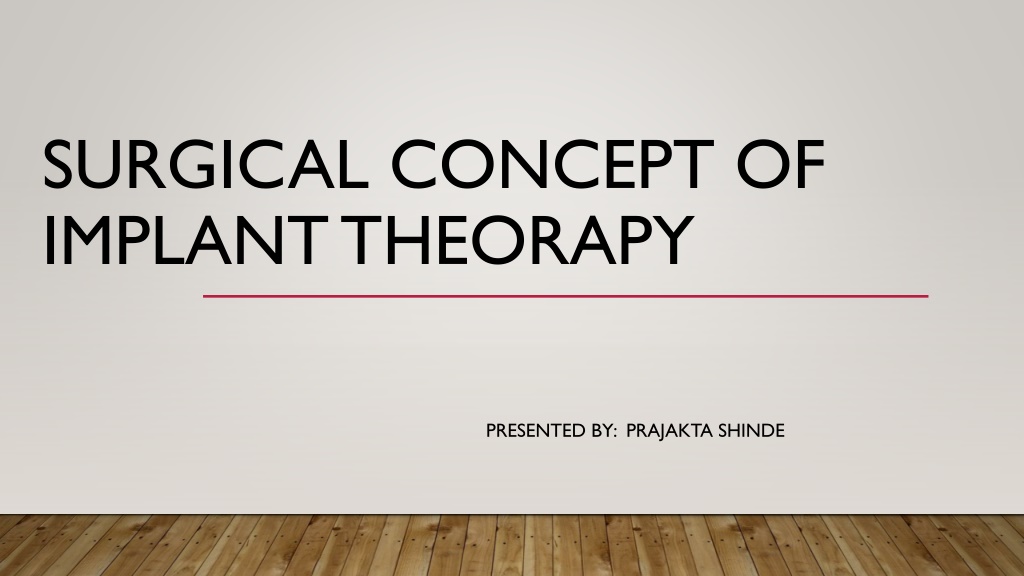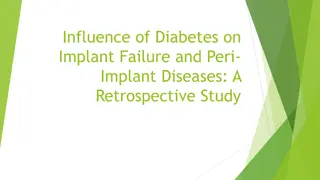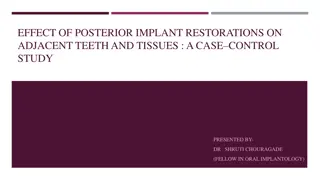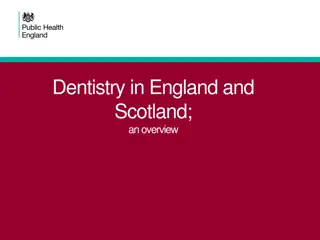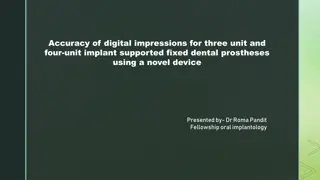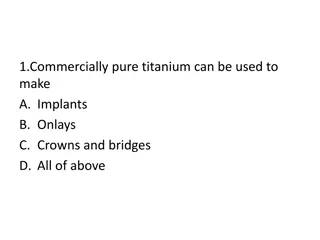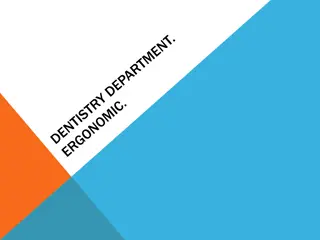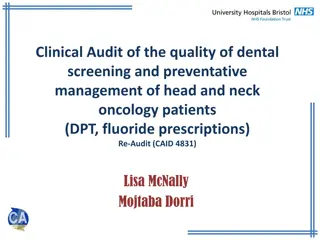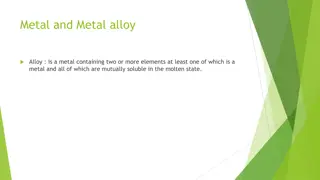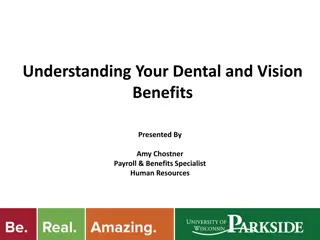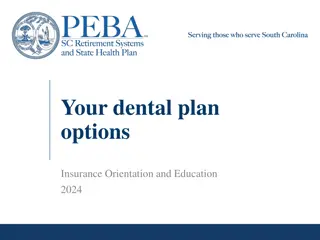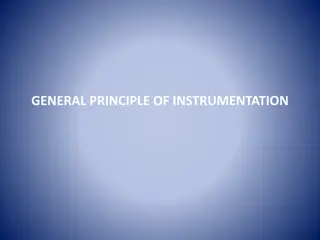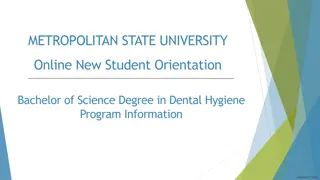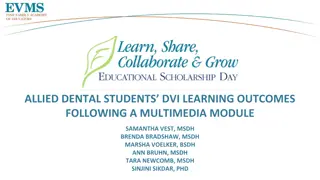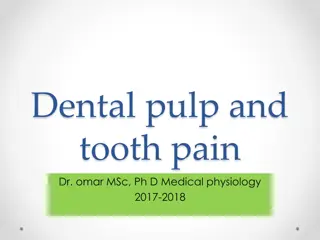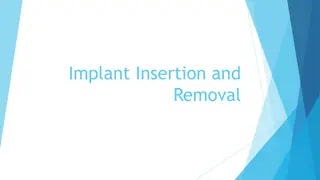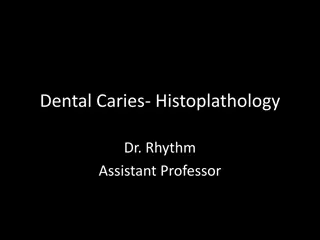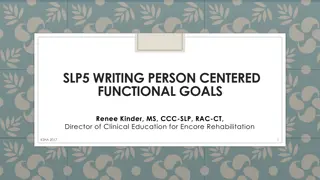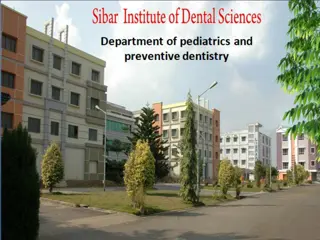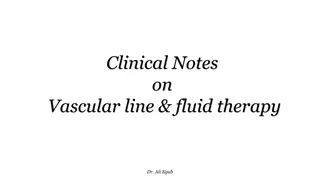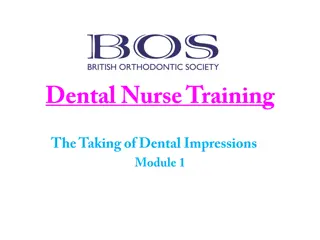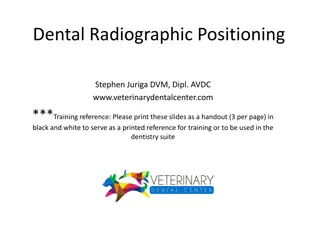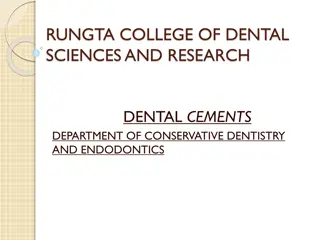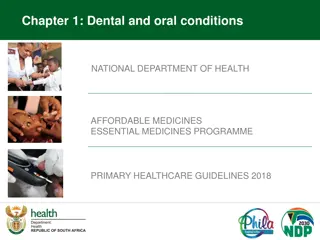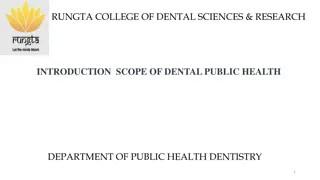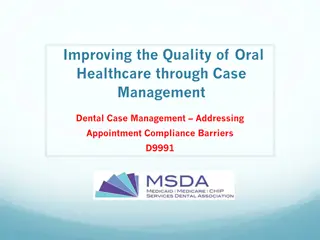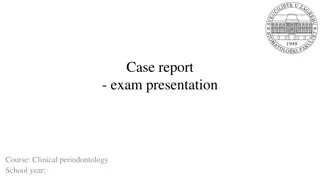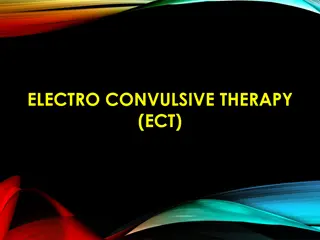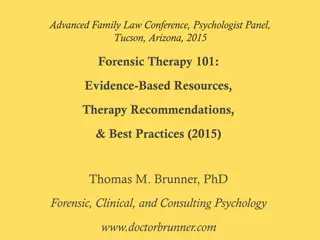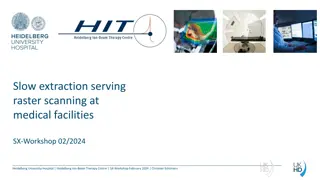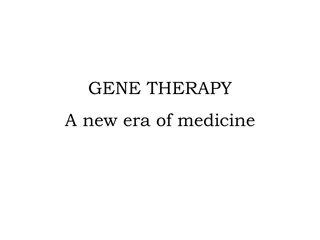Understanding Dental Implant Therapy: A Comprehensive Overview
Dental implant therapy involves the surgical placement of components to support dental prosthetics. The process includes osseointegration, healing time, risks related to surgery, infection, and long-term complications. Successful implants can have high survival rates and long lifespans, with different types available, such as root form implants and zygoma implants.
Download Presentation

Please find below an Image/Link to download the presentation.
The content on the website is provided AS IS for your information and personal use only. It may not be sold, licensed, or shared on other websites without obtaining consent from the author. Download presentation by click this link. If you encounter any issues during the download, it is possible that the publisher has removed the file from their server.
E N D
Presentation Transcript
SURGICAL CONCEPT OF IMPLANT THEORAPY PRESENTED BY: PRAJAKTA SHINDE
A dental implant (also known as an endosseous implant or fixture) is a surgical component that interfaces with the bone of the jaw or skull to support a dental prosthesis such as a crown, bridge, denture, facial prosthesis or to act as an orthodontic anchor.
In the early stages of implant development (19701990), implant systems used a two-stage approach, believing that it improved the odds of initial implant survival. Subsequent research suggests that no difference in implant survival existed between one-stage and two-stage surgeries
The basis for modern dental implants is a biologic process called osseointegrationwhere materials, such as titanium, form an intimate bond to bone. The implant fixture is first placed, so that it is likely to osseointegrate, then a dental prosthetic is added.
A variable amount osseointegration before either the dental prosthetic (a tooth, bridge or denture) is attached to the implant or an abutment is placed which will hold a dental prosthetic. of healing time is required for
THE RISKS AND COMPLICATIONS RELATED TO IMPLANT THERAPY those that occur during surgery (such as excessive bleeding or nerve injury) those that occur in the first six months (such as infection and failure to osseointegrate) those that occur long-term (such as periimplantitisand mechanical failures).
In the presence of healthy tissues, a well integrated implant with appropriate biomechanical loads can have 5-year plus survival rates from 93 to 98 percent. and 10 to 15 year lifespans for the prosthetic teeth.
IMPLANTS EVOLVED INTO 3 BASIC TYPES : 1. Root form implants; the most common type of implant indicated for all uses. 2.Zygomaimplant; a long implant that can anchor to the cheek bone by passing through the maxillary sinus to retain a complete upper denture when bone is absent
3. Small diameter implants are implants of low diameter with one piece construction (implant and abutment) that are sometimes used for denture retention or orthodontic anchorage.
TECHNIQUES USED TO PLAN IMPLANTS To help the surgeon position the implants a guide is made (usually out of acrylic) to show the desired position and angulation of the implants. Sometimes the final position and restoration of the teeth will be simulated on plaster models to help determine the number and position of implants needed.
CT scans can be loaded to CAD/CAM software to create a simulation of the desired treatment. Virtual implants are then placed and a stent created on a 3D printer from the data.
TECHNIQUES USED TO PLAN IMPLANTS To help the surgeon position the implants a guide is made (usually out of acrylic) to show the desired position and angulation of the implants.
MAIN SURGICAL PROCEDURE Fixture installation is done in the first stage surgery. The operator must have a thorough knowledge of fixture installation procedures and detailed knowledge of instrumentation use during this first surgery. The first stage surgery consists of five events, listed as follows 1. Surgical incision of gingiva and mucoperiosteal flap reflection
2. Drilling and countersinking procedures 3. Tapping procedure 4. Fixture installation and cover screw placement. 5. Soft tissue re-adaptation and suture procedures.
The incision line is marked on the crestal ridge between the canine regions. The surgical incision is made with a no. 15 blade and cut through mucosal tissue along the same line. Blade is angled towards the basal body of the mandible. When the muscle fibershave been dissected in the direction of the crestal ridge, the periosteum can be cut. The periosteum is cut carefully 5.0 mm below the crestal ridge between the canine regions but not near the mental foramina.
Use of any of the drilling instruments requires copious saline irrigation. Two methods for irrigation include use of sterile syringes or use of irrigation equipment provided for the System During drilling, the bur is moved in an up-and-down motion into the prepared site to help remove residual bone and maintain adequate cooling as deep into the site as possible.
USE OF TWIST DRILL Use of 2.0 mm Twist Drill The 2.0 mm diameter twist drill is used to enlarge the fixture site. Initially fixture site is prepared closest to the midline. The direction can be checked with the surgical splint for labiolingual orientation, but the mesiodistalorientation should be perpendicular to the alveolar crest.
After the twist drill has been used, a direction indicator into the prepared site is inserted. Next, the most distal site on the left with the 2.0 mm diameter twist drill is prepared
USE OF PILOT DRILL After placement of all direction indicators into prepared sites, use the pilot drill to enlarge the site from 2.0 mm to 3.0 mm diameter. After pilot drilling is finished, the fixture site is enlarged with a 3.0 mm diameter twist drill. This procedure is important for preparing the fixture site to the proper depth.
In the early stages of implant development (19701990), implant systems used a two- stage approach, believing that it improved the odds of initial implant survival. Subsequent research suggests that no difference in implant survival existed between one-stage and two-stage surgeries .
USE OF COUNTERSINK After all fixture sites have been enlarged with either the 3.0 or 3.15 mm twist drills, the countersink procedure is done to all fixture sites to achieve a fixture and cover screw height level with the alveolar bone.
If a short 7.0 mm fixture is to be used, the short countersink should be used for this procedure. After completion of drilling with the high speed motor, each fixture site should be checked with the depth gauge to establish final fixture length.
TAPPING PROCEDURES Tapping is the procedure careful technique the low speed handpiece to avoid heat generation in bone. of creating threads into the fixture site and requires and profuse irrigation. These procedures are completed using Attach the screw tap to the hand-piece connector. Begin tapping the fixture sites from the distal most left site and check using the direction indicators for parallelism.
Do not apply pressure while the threading procedure is being done and continue profuse irrigation. After tapping procedure is completed on one fixture site, fixture installation should follow immediately.
FIXTURE INSTALLATION The fixture is in a forceps and placed into the titanium organizer. titanium cylinder case, then removed with titanium Next, attach a fixture mount to the fixture using the open-ended and long screwdriver. wrench
The fixture is initally installed without irrigation until the horizontal hole of the fixture has threaded into the site and is not visible. In this manner, saline is prevented from being pressed into the narrow space adjacent to the fixture. At the time of the second surgery, mobility is a reliable test for osseointegration.
SECOND STAGE SURGERY Position the explorer near probable fixture sites and insert through the tissues. Change the explorer position slightly to make contact with the cover screw through attached gingiva.
A surgical incision is made approximately five millimeters in length to locate the center of the cover screw. A periosteal elevator is used to reflect the flap and expose all cover screws. When a cover screw is located, the punch blade needle is inserted into the cover screw center hole, pushed apically, and rotated to cut tissues circumferentially. Removal of the cover screw
When the cover screw is exposed, use either a short or long screw driver to unscrew the cover screw . After removing the cover screw, use the punch blade to cut and remove excess periosteum . All excess soft or hard tissue should be removed prior to seating the abutment, otherwise the connection between the fixture and abutment will be incorrect.
REMOVAL OF THE COVER SCREW When the cover screw is exposed, use either a short or long screw driver to unscrew the cover screw. After removing the cover screw, use the punch blade to cut and remove excess periosteum. All excess soft or hard tissue should be removed prior to seating the abutment, otherwise the connection between the fixture and abutment will be incorrect.
ABUTMENT CONNECTION Abutment connection Use the depth gauge to measure the depth of tissue between the fixture head and gingival margin. Abutment lengths are available in various lengths, 3.0, 4.0, 5.5, 7.0, 8.5, and 10.0 mm. In the maxilla, the abutment selected should be at the same height or one millimeter higher than the gingival margin. This is important for esthetic and functional speech purposes.
In the mandible, the abutment selected should be one to two millimeters higher than the gingival margin. . The gingival height changes may require changing the abutment lengths prior to prosthetic treatment.
After connecting the abutment to the fixture, the percussion sound is checked for clarity. When the sound is clear, direct bone anchorage is present. When the sound has a dull quality, this may be indicative of soft tissue interposed between the abutment and fixture. When direct bone anchorage is questionable, design of the prosthesis should be conservative.
Radiographic examination is necessary to verify abutment position on the fixture. If the position is not accurate, the radiograph reveals a space between the abutment and fixture seen as a translucent area. When this occurs, repeat abutment connection procedures and verify with another radiograph
There are different approaches to placement dental implants after tooth extraction. The approaches are: 1. Immediate post-extraction implant placement . 2. Delayed immediate post-extraction implant placement (two weeks to three months after extraction).
3. Late implantation (three months or more after tooth extraction). There are also various options for when to attach teeth to dental implants, classified into: 1. Immediate loading procedure. 2. Early loading (one week to twelve weeks). 3. Delayed loading (over three months)
ONE STAGE TWO STAGE SURGERY . One-stage, two-stage surgery After an implant is placed, the internal components are covered with either a healing abutment, or a cover screw. A healing abutment passes through the mucosa, and the surrounding mucosa is adapted around it.
After an integration period, a second surgery is required to reflect the mucosa and place a healing abutment. In the early stages of implant development (1970 1990), implant systems used a two-stage approach, believing that it improved the odds of initial implant survival. Subsequent research suggests that no difference in implant survival existed between one-stage and two-stage surgeries
When tissue is deficient or mutilated by the loss of teeth, implants are placed and allowed to osseointegrate, then the gingiva is surgically moved around the healing abutments. The down-side of a two-stage technique is the need for additional surgery and compromise of circulation to the tissue due to repeated surgeries.
HEALING AFTER IMPLANT PLACEMENT The osseointegration process observed after implant insertion can be compared to bone fracture healing. Initially, blood is present between the fixture and bone, then blood clot forms.
Extracellular matrix proteins, such as osteocalcin modulate apatite crystal growth and growth factors such as platelet derived growth factor (PDGF) and transforming growth factor beta (TGF-b) are activated which helps in the proliferation of osteoblast
Woven bone is quickly formed in the gap between the implant and the bone, it grows fast up to 100 m per day in all directions. Characterized by a random orientation of its collagen fibrils, high cellularity, and limited degree of mineralization, the biomechanical capacity of woven bone is poor.
Woven bone is progressively replaced by lamellar bone with organized, parallel layers of collagen fibrils and dense mineralizationContrary to the fast-growing woven bone, lamellar bone formation occurs at a slow pace. After 18 months of healing, a steady state is reached where lamellar bone is continuously
TYPESOFIMPLANTSSURGICALGUIDES Surgical guide templates facilitate proper positioning and angulation of the implants in the bone which can decrease clinical and laboratory complications . There are 3 design concepts which are classified based on the amount of surgical restriction offered by the surgical guide templates (1) Nonlimiting design (2) Partially limiting design (3) Completely limiting design
NONLIMITINGDESIGN It only provide an indication to the surgeon as to where the proposed prosthesis is in relation to the selected implant site.
